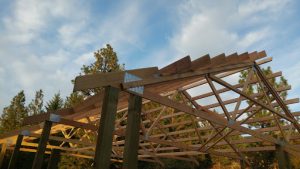Isolating Truss Connector Plates from Treated Lumber
Assembly time for Hansen Pole Buildings’ client BRAD in MOUNT VERNON. Construction has begun upon his new post frame building. Brad had some great questions for Technical Support!
 “I’m not sure if you can answer my question or can possible point me in the correct direction. We are about to attach trusses. I thought that I had read somewhere that we needed to isolate the truss connector plates from the treated poles, if they were in a position where they would contact the columns. Also, is it OK to fasten through these connector plates?
“I’m not sure if you can answer my question or can possible point me in the correct direction. We are about to attach trusses. I thought that I had read somewhere that we needed to isolate the truss connector plates from the treated poles, if they were in a position where they would contact the columns. Also, is it OK to fasten through these connector plates?
Thank you for your time and help on all of the questions we have had so far.”
Mike the Pole Barn Guru responds:
This Construction Manual caution regards ACQ pressure preservative treated lumber only. Each piece of pressure preservative treated lumber will be marked or tagged with an identification of chemicals used for treatment (as well as level of treatment).
Truss plates are produced from sheet steel which is galvanized to ASTM A 653 specifications. The galvanized coating is suitable for use with non-corrosive lumber treatments, including most sodium borate-based preservatives.
This galvanizing is not suitable for direct contact with ACQ treated lumber. A waterproof barrier, such as polyethylene roof underlayment (Vycor or similar), must be placed between any truss plates and ACQ treated lumber. An application example is where the truss heel is attached to a treated wood post. The entire truss plate must be covered with barrier, and care shall be taken not to rip or damage barrier when drilling or installing any fasteners.
In lieu of a waterproof barrier, exposed truss plate surface may be painted as recommended by ANSI/TPI 1-2002 Section 6.51:
Epoxy-Polyamide Primer (SSPC-Paint 22)
Coal-Tar Epoxy-Polyamide Black or Dark Red Paint (SSPC-Paint 16)
Basic Zinc Chromate-Vinyl Butyral Wash Primer (SSPC-Paint 27) and cold applied Asphaltic Mastic (Extra Thick Film) Paint (SSPC-Paint 12).
Keep in mind we, as manufacturers, have to deal in a perfect world where everyone follows everyone else’s rules of best practice and instructions. I’d like to tell you as long as you keep this connection dry, you are highly unlikely to ever have an issue, however there still exists a rare possibility.
If location of a steel connector plate happens to make it impossible to otherwise fasten a truss, place fasteners so they go through “holes” in truss connector plate. BCSI-B8 addresses a similar issue of connectors being placed through a truss plate, “Toe-nailing through a metal connector plate of a truss does not adversely affect the uplift capacity of the Connection provided the truss plate and lumber are not damaged during installation.” https://www.sbcmag.info/sites/sbcmag.info/files/article/2007/01/bcsi_chapter_8_pdf__15339.pdf.
Of interest, some metal plate connected wood truss manufacturers use nail guns to set steel plates, prior to trusses being pushed through a roller press, setting them permanently.







Hi, folks,
I’m not doing a pole barn, but am trying to re-deck a 30 year old treated lumber fresh water boat dock.
Right now, it looks like MCA-treated lumber with HDG fasteners might be an OK bet.
Can you give me any advice about (a) whether MCA-treated Ground Contact lumber will be safe to use with a steel dock frame and HDG fasteners, or should I consider some way to isolate the wood from the metal fittings, e.g., something like Vycor joist tape?
Thx, in advance
MCA treated wood should not reactive negatively with metals, unlike ACQ.